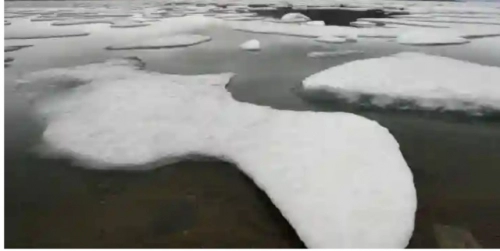No Fewer Than 100 Million African Children Have Been Vaccinated Against Polio In The Past One Year, The World Health Organisation
Communications And EntertainmentSports And FitnessNews And PoliticsHealth And LifestyleBusiness And MoneyArts And EducationPersonal Care And BeautyGive AidMotivationalsRelationship And MarriageFamily And HolidaysOthersReligion And PrinciplesStories And PoemsScience And TechnologyUSMLE And MedicalsIT And Computer ScienceFood And KitchenVehicles And MobilityEngineeringHobbies And HandiworksSocial Sciences
profile/1407tmp-cam-1936261485.jpg
Akbon

Arctic To Be Functionally Ice-free In The Next 50 Years, Study Says
~3.6 mins read
Arctic to be ‘functionally ice-free’ in the next 50 years, study says
globalnews.ca
Researchers at the University of California’s Center for Climate Science say a “functionally ice-free” Arctic can be expected within the next 50 years.
A study published in the journal Nature Climate Change predicts that if the Earth continues at its current rate of greenhouse gas emissions, Arctic sea ice would regress to levels not high enough to perform its function of reflecting heat back — levels that can be reached as early as September 2044 and no later than 2067.
Previous models of sea ice melt have disagreed widely on a consensus for prediction, with some projecting an ice-free September by 2026 or one as late as 2132, according to a press release from UCLA.
September is used as the benchmark for models because it’s the time when sea ice levels are at their lowest, due to the melt from summer heat.
Chad Thackeray, the study’s lead author, told Global News that one reason why predictions differ so much was in how they represent the sea ice Albedo feedback cycle — a process whereby current sea ice retreat reveals a darker seawater surface in the Arctic, allowing more sunlight to be absorbed and thus accelerating ice melt.
“It’s a positive feedback that sort of amplifies an initial change, sort of continues and continues in its cycle, and so this change can cause greater warming,” said Thackeray.
Thackeray and co-author Alex Hall made use of a new method to model their prediction of sea ice melt.
Using 23 different models of ice melt and comparing them to about 30 years of satellite data, Thackeray and Hall isolated the most consistent results to narrow the range of their prediction, picking the best six overall.
Currently, sea ice in September averages a surface area minimum of five to six million square kilometres. Thackeray said that once the sea ice melts to an area under one million square kilometres, the Arctic would then be defined as “functionally ice-free.”“So once we get below this sort of one-million kilometres squared, it’s seen as somewhat of a tipping point, where it might take a substantial amount of time for the ice to be able to grow back after its completely disappeared,” Thackeray told Global News.
Thackeray’s study did, however, have its limits — geographic data was limited to sea ice in the area 70 to 90 degrees North latitude, according to Thackeray.
“There is a certain of the Canadian Arctic that’s cut off, say like the Northwest Passage route,” said Thackeray.
“Essentially just to simplify our study area, you have less to interact with.”
Despite the limit of the area study, Thackeray said that the results of the study are still the same regardless of the measurement.
“Those aren’t the areas that are holding on to the ice the longest in the future. It’s areas right around the northern coast of Greenland and the far north Canadian archipelago,” said Thackeray.
“These areas below 70 aren’t the areas that hold on the ice the longest anyways — they’ll be free of ice even sooner than that.”
When asked when or how long the sea ice in the Arctic would take to grow back, Thackeray responded with, “We don’t have a scenario for re-growth.”
profile/1407tmp-cam-1936261485.jpg
Akbon

100m African Children Vaccinated Against Polio - WHO
~4.0 mins read
No fewer than 100 million African children have been vaccinated against polio in the past one year, the World Health Organisation (WHO) has said.
WHO Regional Director for Africa, Dr Matshidiso Moeti said that although COVID-19 had threatened the success of polio vaccination, it was possible to overcome the final hurdles.
Moeti, in a statement, stated that WHO had the know-how, but needed to be backed by committed resources to reach all under-vaccinated communities.
The polio programme has a history of supporting the response to emerging health threats in the region, including Ebola and COVID-19, and half of polio surge staff are currently helping countries with COVID-19 surveillance, contact tracing and community engagement.
According to WHO, African states overseen by the African Regional Office of WHO remained committed to ending all remaining forms of polio.
The Regional Office has also presented a scorecard to track progress towards the eradication of the virus as the Africa was certified free of wild poliovirus one year ago, after four years without a case.
However, outbreaks of a vaccine-derived poliovirus (cVDPV) is spreading in African communities where too few children have received the polio vaccine.
Related News
cVDPV is a weakened strain of the virus that has changed over time and behaves more like the naturally occurring poliovirus.
Since 2018, 23 African countries have experienced outbreaks and more than half of the 1071 global cVDPV cases were recorded in Africa.
According to WHO, cases increased in 2020 partly because of disruptions to polio vaccination campaigns caused by the outbreak of COVID-19 pandemic.
Meanwhile, WHO has said that the next three months will be a critical period for stepping up global collective action against future pandemics, citing three major meetings on the international agenda.
WHO is progressing with plans to strengthen global defense against future epidemics and pandemics, he said, pointing at the UN General Assembly in September, followed by the G20 Summit in October, and a special session of WHO’s governing body set for November.
The next three months, therefore, represent “a critical period for shaping the future of pandemic preparedness and responseâ€, he added
WHO said that the commitments came at the just concluded virtual 71st meeting of the WHO Regional Committee for Africa.
Copyright © 1994 - 2021 Copyright: PM News
Advertisement

Link socials
Matches
Loading...
